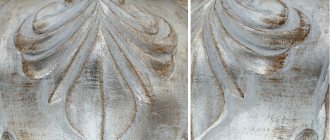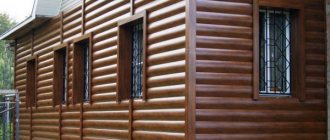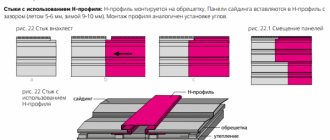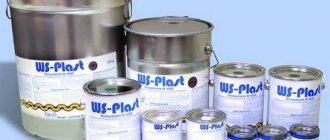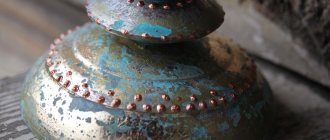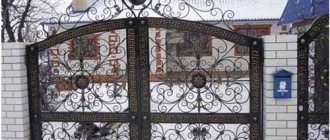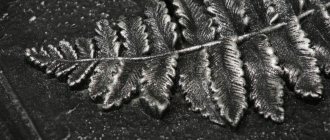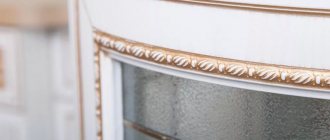Properties of patina
The name “patina” was invented by the Italians. Patina was originally thought to be a naturally occurring coating on copper. It did not always look like a work of art, but over time it became fashionable to have “antique” forged products in homes. Demand creates supply and patina began to be applied to metal artificially, using acids and oxidizing agents . As a result, the interior items looked great.
But in addition to purely decorative properties, patina also has important practical meaning:
- protects the metal from external influences;
- protects against rust;
- gives the surface water-repellent properties.
Patination of forged products with paint
Before starting work, you need to prepare the product:
- the metal must be thoroughly cleaned of scale;
- then the product is degreased with a special primer;
- Next, the metal should be primed and painted (the primer is applied to protect the product from rust, which is the scourge of all metals, and the paint is applied to protect the primer from external influences).
The following types of paints are suitable for subsequent patination of a forged product:
Alkyd . Alkyd paints are the cheapest of the paints suitable for patination, but they also have the worst properties. Alkyd paints are recommended to be used exclusively in cases where the surface to be patinated is outdoors and has a large area (in this case, when using alkyd-based paints, you can save a lot).
Textured . Textured paints are ideal if the room designer wants to give forged materials a visual roughness and matte tint; in other cases, the best solution would be to use other types of paints.
Hammer . Hammer paints give a forged product a beaten effect, visually “breaking” the product into fragments. Hammer paints are ideal for forged products used in rooms decorated in an avant-garde style, but it is preferable to use them only indoors - they quickly lose their properties in the air.
Powder . Powder paints have an almost ideal set of properties - they are quite durable, high quality and relatively inexpensive, however, such paints have one significant limitation on their use - powder paints can only be used for painting forged products that have not previously been welded or mounted.
Electrostatic . Of all the above types of paints, it is electrostatic paints that have the best quality, but you have to pay dearly for such properties.
Having painted the forged product in the main color and waited until the paint has completely dried, you can proceed directly to patination. Patination is usually carried out in contrast:
- if the main color of the forged product is dark, then patination should be done using light paints;
- if the main color of the metal is light, then patination should be carried out using paints of dark tones.
- if the metal to be patinated has a textured structure (non-uniform surface), then its entire surface can be safely patinated;
- if the product is quite smooth, then the best solution in this case would be patination of individual elements (for example, curls, flowers, ornaments, patterns and similar decorations).
List of materials and tools
Patination should be carried out in a well-ventilated area or in the open air to protect the respiratory system from harmful influences. You will need:
- patina of the required color;
- solvent;
- a synthetic brush or sponge if you need to treat a small surface;
- small containers made of plastic or glass (for example, you can use cut bottoms from plastic bottles);
- item made of metal;
- varnish;
- alcohol.
- palette.
Important! Patination should always be carried out wearing thick gloves. You will need to work with oxidizing agents and therefore, if safety precautions are not followed, there is a possibility of getting a chemical burn.
Types of patina
Patinas are sold in stores in the form of pastes, liquids and varnishes.
- Acrylic. It is made on a water basis. Suitable for metal, wood and plaster products. Differs in versatility and ease of application. Protects metal from external influences
- Oily. Does not hide the natural shade of the metal and emphasizes its pattern.
- Chemical _ It is made by combining water-based paint and an oxidizing agent. Due to a chemical reaction, the forged product “ages” in a few hours. Thus, the metal actually changes.
Important! During operation, the patina in a jar or in a special container must be stirred periodically.
Patination of metal
Initially, the effect of aged metal was achieved by applying chemical reagents to the metal surface. But modern craftsmen prefer to use special dyes for these purposes that have a visual effect, but preserve the integrity and performance properties of the product. Such coloring compositions include:
- bitumen varnish;
- acrylic paints (including water-based);
- alcohol solution of shellac resin;
- wax and oil patina.
Application techniques may vary (depending on the composition).
Decorative possibilities of patina
With the help of patination you can achieve an interesting color combination, a combination of different textures, matte and glossy surfaces.
Choose the shade of the composition based on the type and main color of the product:
- Bronze shades look good in a classic interior. These tones are suitable for forged furniture and interior decor.
- Green tones are also suitable for a room decorated in a classic style. It is worth considering that green patina looks organic on copper, bronze and brass surfaces.
- Cool shades of silver are appropriate in neo-classics. These colors go well with stone and glass.
- Gold is suitable for interiors in baroque, loft, and art deco styles. This type of patina is also appropriate in the exterior - to accentuate the elements of forged gates, fences, and gazebos.
Preparing metal for patination
- Prepare a smooth surface on the forged product. Remove uneven areas with a file and sandpaper, and then coat the item with a special metal primer. Check that there are no rust stains left.
- Before decorating a forged item, paint the product, and then be sure to let the paint dry . The paint will cover the primer layer and create a spectacular background for the future patina. Gold or silver patina looks especially good on dark tones.
The use of patina in forged elements
Patination is an artificial method of aging metal to give it a unique and noble appearance. Elements of products made of iron, bronze, copper, and brass are perfectly suitable for painting. The chemical method of coloring products is extremely labor-intensive and not safe for humans. Over time, they began to simplify this work process.
Light patination of forged railing elements
Forging with patina WS Plast - golden bronze
Patina on forged products
Forged railings with patina
The use of a variety of paint and varnish coatings simplified the complex method of chemical patination. You need to have an understanding of what goals you are pursuing by applying a patina. What kind of patina should I use? Patina is presented in a variety of colors and chemical elements. Let's consider patina, which is necessary for decorating metal, for example, creating forged products. Important colors: greens, copper, gold, silver, bronze, chameleon.
Secrets of patination
The choice of patination method depends on the result you require.
If you apply patina with a sponge, the layer will come out very heterogeneous and light. Suitable if your goal is only to emphasize some place on the product.
Apply paint to kinks and corners. Thus, a “time imprint” will appear on the item.
Important. When working with a sponge, apply light strokes to the material. Otherwise, a trace of foam rubber will appear on the item, which will have to be washed off or covered with a new layer.
What nuances should you consider if you decorate metal with a brush?
- The brush bristle must be dry and clean. Otherwise, dirty spots will remain on the metal and instead of the desired effect you will get a “painted fence”.
- Apply a little patina to the palette and rub it in with a brush. After this, start covering the material with sweeping movements.
- The brush is suitable for applying deeper layers of patina when the effect of light strokes is not enough.
- If you need to make the paint more transparent, dilute it with a solvent. Adjust the proportions to your taste.
- Didn't the plot work out? Wipe the area where the patina was applied incorrectly with a cloth and brush again.
Applying patina (1 video)
Patina
To achieve excellent results, it is recommended to use expensive acrylic or alkyd compounds. Reputable manufacturers WS-Plast (Germany), as well as Tikkurila, have proven themselves to be excellent. First, the metal is prepared for painting: scale is removed, degreased, then primed and paint is applied. Mostly matte paint is chosen. After the metal has completely dried, specialists begin to apply the patina. It is applied with a dry brush in small portions, and for this you need to take it in moderation. After applying it to the palette, let it dry slightly, and then rub it in the convex places so that no strokes are visible. Patina can also be applied to the convex parts of the decor. It is possible to combine shades of patina (gold-silver-white gold). It is not uncommon to use gold leaf or gold leaf to decorate forged products; gilding of both individual elements and the entire product is possible, depending on the task at hand.
Compositions for patination
Currently, craftsmen use the following materials to apply patina:
- Bitumen varnish - applied to the surface with a brush or textile swab, after which the resulting excess is wiped off. Depending on the amount of composition used, varying degrees of darkening can be achieved.
- Acrylic paints are diluted with water and poured into recesses in the relief. Due to its versatility, this material is equally effective when working with any objects.
- Shellac varnish is a solution of resin in ethyl alcohol. Such compositions are not only used as a protective layer, but also make the color of the product rich and expressive. Materials of this type are also widely used in woodworking. They have a resinous scent, dry quickly and are comfortable because they only require the use of a special synthetic brush.
- Chemical patina is a mixture of an oxidizing agent and a water-based metallic paint. The reaction that occurs between these elements creates the characteristic effects of long-term oxidation on the metal surface.
It is quite difficult to reproduce natural shades, so they are preferred only by principled antique aesthetes. Today, the most common are universal color schemes that combine much better with each other. Examples include white wrought iron window grilles adorned with brown or emerald green swirls and leaves, as well as dark fences with gold or silver accents. The use of the patination method helps to visually increase the weight of the product and makes individual structural elements more significant.
